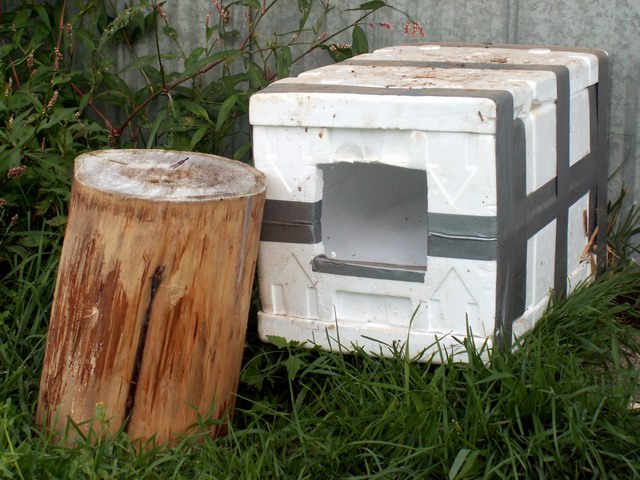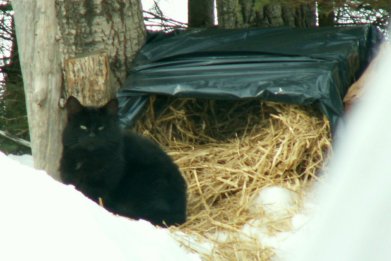
![]() Home
Home ![]() Adopt A Cat
Adopt A Cat ![]() Adopt A Dog
Adopt A Dog ![]() Donate
Donate ![]() Memorials
Memorials ![]() Upcoming Events
Upcoming Events ![]() Merchandise
Merchandise ![]() Volunteering
Volunteering ![]() Fostering
Fostering ![]() Contact Us
Contact Us ![]()
Caring for Ferals in the Winter Months
| When Fall arrives, it is time to consider the feral cats and how to prepare best for the colder temperatures and their well being.
Each area of the country and the world is obviously different in temperatures and seasons, therefore not all feral cats need the same level of preparation for winter. For this reason you will find the following information listed by type of preparation rather than one broad brush approach for this topic. However, for ANY type of "winterizing" for your ferals, always consider the following:
|
|
 |
Here's an example of a home-made cat shelter. It's made from two styrofoam boxes held together with duct tape. The lids are taped to the top and bottom to reinforce its insulating capabilities. The inside is lined with fresh straw, nice soft cotton batting, or old towels or blankets. Remember to ensure they are always clean and dry. Once the cat is inside, its own body heat is retained by the styrofoam, and the cat stays toasty warm. These shelters are extremely inexpensive to make. This one is particularly good for strays who might seek shelter in an unheated barn or garage where there is no wild animal danger to them. |
| If you want a shelter similar to this to place in an area where there may be potential danger to the stray from wild animals (ie: near a woodpile, stand of trees, behind a building, etc, - anywhere cold and hungry strays may come to seek food and shelter) the location of the shelter is very important, and it must be modified a bit from the photo above. It should be placed so that the stray can have a good view of any approaching danger, yet be sheltered from the wind. It should also have a back door, so that the stray may have an escape route if located and confronted by a predator. This shelter can actually be covered with snow, allowing an entrance and exit tunnel. This will further help hide the shelter, and provide additional insulation and heat retention. |
|
| Another simple, practical, quick and inexpensive shelter is simply a cardboard box filled with loose straw. Place the box inside a garbage bag to keep the cardboard dry, and you've got another great shelter! The cat will be ever so grateful for a warm place to nest in cold and wet weather. This one was used by Eli during the cold winter days of March, 2008. Although he wasn't feral, he was a very scared stray, and this shelter kept him warm and dry. He's now safe and warm and back home with his original family after being lost for about 6 months. |
 |

Home | Adopt A Cat | Adopt A Dog | We Found Homes! | Articles | Feral Cats | About Us |
||
♥ This website lovingly created and maintained by DunRoamin' volunteers ♥ |
